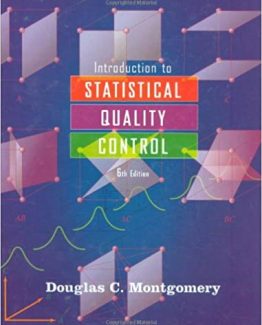Fundamental Mechanics of Fluids 4th Edition by I.G. Currie, ISBN-13: 978-1439874608
[PDF eBook eTextbook]
- Publisher: CRC Press; 4th edition (August 1, 2012)
- Language: English
- 608 pages
- ISBN-10: 9781439874608
- ISBN-13: 978-1439874608
Fundamental Mechanics of Fluids, Fourth Edition addresses the need for an introductory text that focuses on the basics of fluid mechanics―before concentrating on specialized areas such as ideal-fluid flow and boundary-layer theory. Filling that void for both students and professionals working in different branches of engineering, this versatile instructional resource comprises five flexible, self-contained sections:
Table of Contents:
Part I: Governing Equations
Basic Conservation Laws
Statistical and Continuum Methods
Eulerian and Lagrangian Coordinates
Material Derivative
Control Volumes
Reynolds’ Transport Theorem
Conservation of Mass
Conservation of Momentum
Conservation of Energy
Discussion of Conservation Equations
Rotation and Rate of Shear
Constitutive Equations
Viscosity Coefficients
Navier–Stokes Equations
Energy Equation
Governing Equations for Newtonian Fluids
Boundary Conditions
Flow Kinematics
Flow Lines
Circulation and Vorticity
Stream Tubes and Vortex Tubes
Kinematics of Vortex Lines
Special Forms of the Governing Equations
Kelvin’s Theorem
Bernoulli Equation
Crocco’s Equation
Vorticity Equation
Part II: Ideal-Fluid Flow
Two-Dimensional Potential Flows
Stream Function
Complex Potential and Complex Velocity
Uniform Flows
Source, Sink, and Vortex Flows
Flow in Sector
Flow around Sharp Edge
Flow due to Doublet
Circular Cylinder without Circulation
Circular Cylinder with Circulation
Blasius Integral Laws
Force and Moment on Circular Cylinder
Conformal Transformations
Joukowski Transformation
Flow around Ellipses
Kutta Condition and Flat-Plate Airfoil
Symmetrical Joukowski Airfoil
Circular-Arc Airfoil
Joukowski Airfoil
Schwarz–Christoffel Transformation
Source in Channel
Flow through Aperture
Flow Past Vertical Flat Plate
Three-Dimensional Potential Flows
Velocity Potential
Stokes’ Stream Function
Solution of Potential Equation
Uniform Flow
Source and Sink
Flow due to Doublet
Flow near Blunt Nose
Flow around Sphere
Line-Distributed Source
Sphere in Flow Field of Source
Rankine Solids
D’Alembert’s Paradox
Forces Induced by Singularities
Kinetic Energy of Moving Fluid
Apparent Mass
Surface Waves
General Surface-Wave Problem
Small-Amplitude Plane Waves
Propagation of Surface Waves
Effect of Surface Tension
Shallow-Liquid Waves of Arbitrary Form
Complex Potential for Traveling Waves
Particle Paths for Traveling Waves
Standing Waves
Particle Paths for Standing Waves
Waves in Rectangular Vessels
Waves in Cylindrical Vessels
Propagation of Waves at Interface
Part III: Viscous Flows of Incompressible Fluids
Exact Solutions
Couette Flow
Poiseuille Flow
Flow between Rotating Cylinders
Stokes’ First Problem
Stokes’ Second Problem
Pulsating Flow between Parallel Surfaces
Stagnation-Point Flow
Flow in Convergent and Divergent Channels
Flow over Porous Wall
Low Reynolds Number Solutions
Stokes Approximation
Uniform Flow
Doublet
Rotlet
Stokeslet
Rotating Sphere in Fluid
Uniform Flow Past Sphere
Uniform Flow Past Circular Cylinder
Oseen Approximation
Boundary Layers
Boundary-Layer Thicknesses
Boundary-Layer Equations
Blasius Solution
Falkner–Skan Solutions
Flow over a Wedge
Stagnation-Point Flow
Flow in Convergent Channel
Approximate Solution for Flat Surface
General Momentum Integral
Kármán–Pohlhausen Approximation
Boundary-Layer Separation
Stability of Boundary Layers
Buoyancy-Driven Flows
Boussinesq Approximation
Thermal Convection
Boundary-Layer Approximations
Vertical Isothermal Surface
Line Source of Heat
Point Source of Heat
Stability of Horizontal Layers
Part IV: Compressible Flow of Inviscid Fluids
Shock Waves
Propagation of Infinitesimal Disturbances
Propagation of Finite Disturbances
Rankine-Hugoniot Equations
Conditions for Normal Shock Waves
Normal-Shock-Wave Equations
Oblique Shock Waves
One-Dimensional Flows
Weak Waves
Weak Shock Tubes
Wall Reflection of Waves
Reflection and Refraction at Interface
Piston Problem
Finite-Strength Shock Tubes
Nonadiabatic Flows
Isentropic-Flow Relations
Flow through Nozzles
Multidimensional Flows
Irrotational Motion
Janzen–Rayleigh Expansion
Small-Perturbation Theory
Pressure Coefficient
Flow over Wave-Shaped Wall
Prandtl–Glauert Rule for Subsonic Flow
Ackeret’s Theory for Supersonic Flows
Prandtl–Meyer Flow
Part V: Methods of Mathematical Analysis
Some Useful Methods of Analysis
Fourier Series
Complex Variables
Separation of Variable Solutions
Similarity Solutions
Group Invariance Methods
Appendix A: Vector Analysis
Vector Identities
Integral Theorems
Orthogonal Curvilinear Coordinates
Appendix B: Tensors
Notation and Definition
Tensor Algebra
Tensor Operations
Isotropic Tensors
Integral Theorems
Appendix C: Governing Equations
Cartesian Coordinates
Cylindrical Coordinates
Spherical Coordinates
Appendix D: Fourier Series
Appendix E: Thermodynamics
Zeroth Law
First Law
Equations of State
Enthalpy
Specific Heats
Adiabatic, Reversible Processes
Entropy
Second Law
Canonical Equations of State
Reciprocity Relations
Iain G. Currie is a Professor Emeritus in the Department of Mechanical and Industrial Engineering at University of Toronto, Canada. He holds a Bachelor’s degree in Mechanical Engineering from the University of Strathclyde, a Master’s degree from the University of British Columbia, and Ph.D. from the California Institute of Technology. He has taught fluid mechanics at the undergraduate and graduate levels for many years. His research involves fluid structure interactions, and he has become involved in studying low Reynolds number flows of both Newtonian and non-Newtonian fluids.
What makes us different?
• Instant Download
• Always Competitive Pricing
• 100% Privacy
• FREE Sample Available
• 24-7 LIVE Customer Support






Reviews
There are no reviews yet.